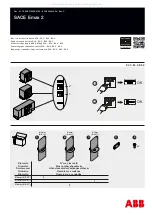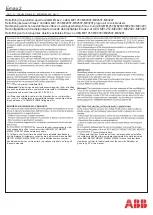
GEI-86134, Power Circuit Breakers
3
4
5
1. Special 2500A Fuse
2. Disconnect Key
3. Heat Sink
4. Upper Barrier
5. Primary Disconnect
Fig. 12.
AKRU-50 breaker with special 250oA fuse
Special 2500A Fuse for AKRU-50
This fuse provides a melting time-current char
acteristic that coordinates with 1600A trip devices.
Compared physically with a 2500A NEMA Class L
fuse, the special fuse is more compact (shorter);
its tangs are specially configured and offset to
achieve the required pole -to-pole fuse spacing; a
special primary disconnect assembly mounts directly
on the outboard tang of the fuse. Considering their
unique mounting provisions, when replacing these
fuses the following procedure should be adhered to
(Refer to Fig. 12):
1. Remove the primary disconnect assembly
from the fuse tang, accomplished by first loosening
the two keys (2) via their holding screw and pulling
them upward and out. After the keys are removed,
pull the disconnect assembly off the end of the fuse
tang.
NOTE:
This removal does not disturb the
disconnect's clamping force adjustment.
2. Remove the upper barrier (4) .
3. Detach the inboard end of the fuse by remov
ing the two
1/2
inch
-
13 bolts. A ratchet and
socket with a short extension will be required.
12
4. Remove the heat sink (3).
5. Remove the fuse.
6. Install the new fuse by reversing the dis
assembly procedure. Ensure that the mating faces
of the fuse and heat sink are clean.
CAUTION:
WHEN
REPLACING
THE
FUSE IN THE LEFT POLE (FRONT
VIEW) OF THE BREAKER, NOTE PAR
TICULARLY
THAT
THIS
FUSE
IS
MOUNTED DIFFERENTLY THAN THE
OTHER TWO FUSES.
AS SHOWN IN
FIG. 14, FOR THIS PHASE THE FUSE
IS ROTATED 180 DEGREES ABOUT ITS
AXIS SO THAT ITS INBOARD TANG IS
POSITIONED BENEATH THE BREAKER
STUD.
THIS TANG IS OFFSET WITH
RESPECT TO THE OPPOSITE END (SEE
FIG. 13, SO THAT ROTATING THE FUSE
DOES NOT ALTER THE POSITION OF
THE PRIM ARY DISCONNECT.
Open Fuse Lockout Device
Refer to GEK-7310A, page 31.
www
. ElectricalPartManuals
. com



































